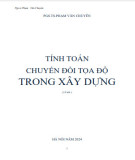
Journal of Science and Technique - ISSN 1859-0209
21
AN APPROACH TO DETERMINING AND PREDICTING THE MEAN
PARTICLE SIZE OF A MUCK PILE AFTER BLASTING ACCORDING
TO SWEBREC PARTICLE SIZE DISTRIBUTION LAW BASED ON THE
FORM OF SINGLE SPHERICAL CHARGE IN LABORATORY SCALE
Tung Lam Vu1,*, Duc Hieu Vu1, Xuan Bang Vu2
1Institute of Techniques for Special Engineering, Le Quy Don Technical University
2Engineering Arms
Abstract
In the manufacturing procedure at open-pit mines, tunnel construction or channel excavation
activities, crushing rocks to a suitable grain size is one of the first technological steps, directly
affecting the efficiency of the following steps in the overall process of drilling - blasting -
loading - transporting. Currently, drilling-blasting is still an effective method in this field.
However, controlling the blasting parameters to obtain a suitable mean particle size is still
difficult for mining engineers and scientists. Hence, on a laboratory scale, this research
carries out 6 blasting experiments based on the form of single spherical charge with a variety
of powder factors but the same specimen condition, equations determining directly the
Swebrec particle size distributions (PSDs) law are then established with the input data taken
from sieve analysis, as a basis for establishing relationships among each pair of parameters
such as the exponential coefficient of Swebrec PSD function b, the mean particle size Dtb,
and the powder factor q. The results show that the obtained PSDs almost completely fit
experimental data, coefficients of determination R2 for the entire data set are greater than
0.99. Each pair of relationships among b, Dtb, and q has R2 values greater than 0.98 with the
addition of predictive significance. The calculations are modularized in Python programming
language for use as a package. Compared to other existing methods, the final results can help
quickly evaluate the quality of an explosion, appropriately calibrating explosion parameters
to obtain the desired rock fragmentation without requiring knowledge of machine learning
and statistics.
Keywords: Rock fragmentation; particle size distribution (PSD); Swebrec function; comminution;
mean particle size.
1. Introduction
According to several research and blasting experts, the effective blasting energy to
break rocks is only above 20%, and most of them cause negative impacts on the
* Corresponding author, email: lamvt@lqdtu.edu.vn
DOI: 10.56651/lqdtu.jst.v7.n02.879.sce















